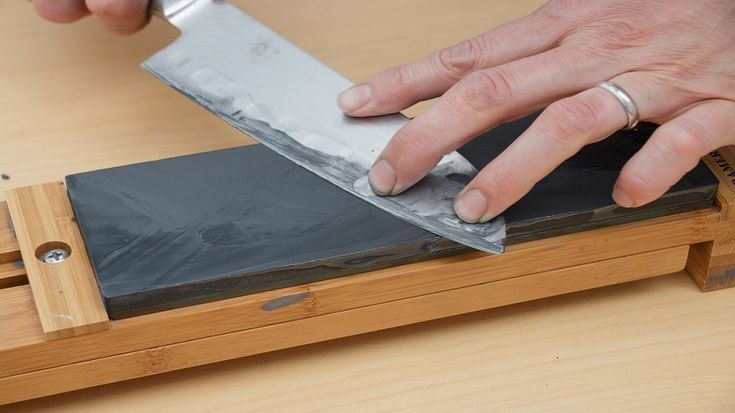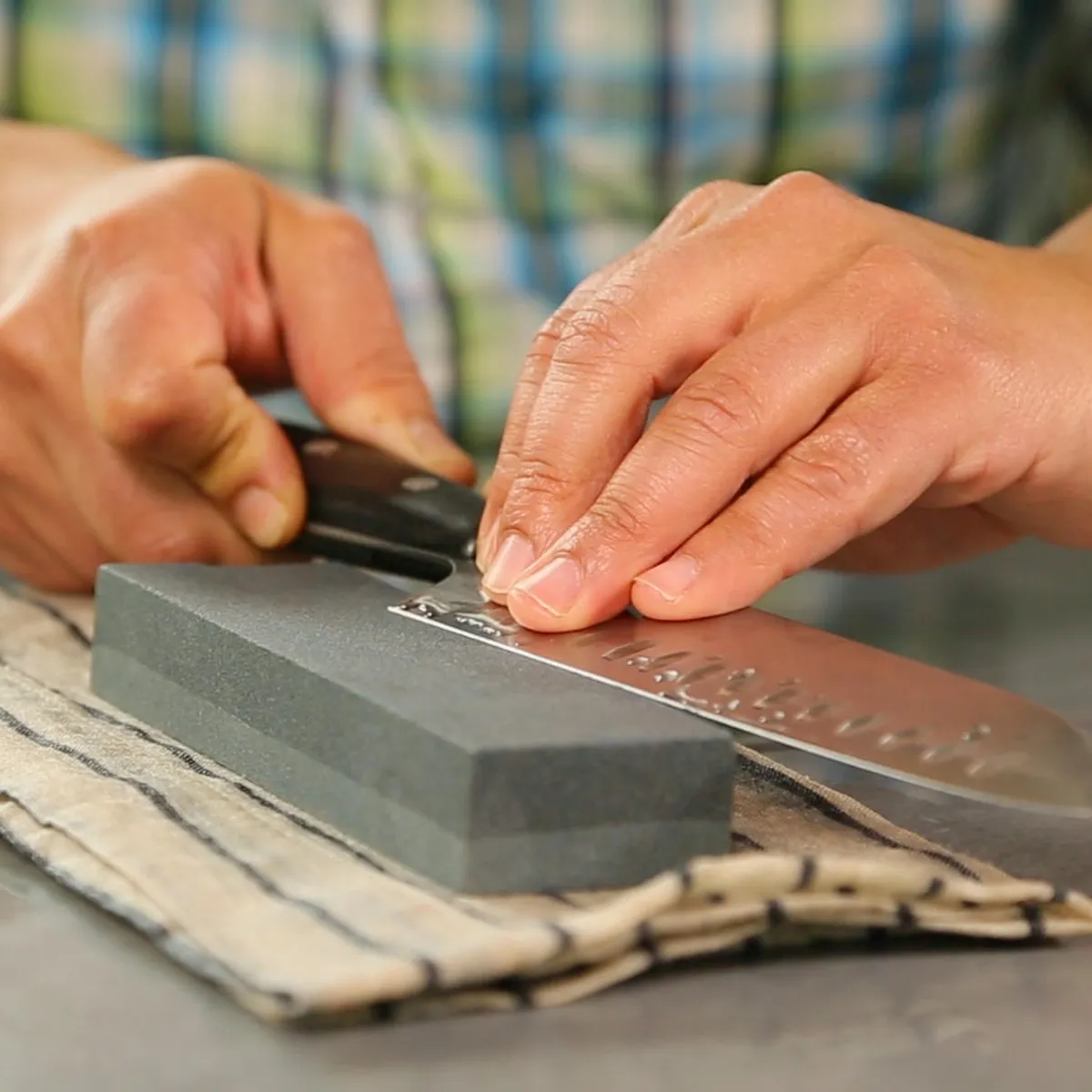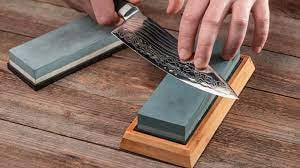Imagine your kitchen as a stage where your knives are not just tools but performers, each requiring the best possible condition to perform flawlessly. Just as a sharp mind makes tasks effortless, a sharp knife transforms cooking from a chore into an art. However, the reality of dull knives can turn this art into a risky struggle. Knowing how to keep knives sharp at home isn’t just about culinary precision, it’s a vital practice to keep your kitchen knives sharp and ensure safety and efficiency in your culinary space.
Keeping your knives sharp is essential not only for efficiency and ease in the kitchen but also for safety. A sharp knife cuts with less effort and more control, significantly reducing the risk of accidents. Conversely, dull knives require more force to operate, increasing the likelihood of slipping and causing injury. Beyond safety, sharp knives are crucial for culinary excellence. They make clean cuts that improve the texture and presentation of your dishes and ensure even cooking. This guide will walk you through the fundamentals of knife maintenance, from the basics of sharpening and honing to proper handling and storage, equipping you with the knowledge to keep your blades in top condition.
Knife Maintenance Essentials
Why Keeping Knives Sharp Is Important
Keeping your knives sharp is more than just a culinary best practice; it's a fundamental aspect of kitchen safety and efficiency. A sharp knife is crucial because it provides precision and ease during cutting, which is essential for both the quality of your food and your safety. When knives are sharp, they require less force to cut through food. This not only makes the cutting smoother but also significantly reduces the risk of the knife slipping and causing an injury.
Dull knives, on the other hand, can make food preparation a laborious and dangerous task. They require more pressure, which increases the chance of the knife slipping and potentially leading to cuts or accidents. This is why regular knife maintenance is not just recommended; it's critical for anyone who spends time cooking at home. It ensures that you can prepare meals efficiently and safely.
Additionally, sharp knives contribute to culinary precision. They allow for cleaner cuts, which improves the texture and appearance of the dish and ensures that food cooks more evenly. Therefore, maintaining the sharpness of your knives means maintaining the quality of your food.
Knife Safety and Handling
How to Hold a Knife
Properly holding a knife not only ensures precision in your cuts but also significantly increases kitchen safety. The recommended method is the two-finger pinch. Here’s how to do it:
- Pinch Grip: Start by pinching the base of the blade — where it meets the handle — between your thumb and your index finger. This part of the blade is often called the "heel."
- Secure the Handle: Wrap your remaining three fingers around the handle. This grip gives you stability and control, making your knife an extension of your hand.
It's crucial to remember never to attempt catching a knife that slips off the counter or cutting board. Let it fall safely to the ground to avoid any injuries, then pick it up carefully.
Kitchen Knives Are for Food Only
Kitchen knives are designed specifically for preparing food and should be used accordingly to preserve their sharpness and integrity.
- Appropriate Usage: Use your knives only for their intended culinary tasks, such as slicing, dicing, and chopping food. Using them to pry open containers, cut through packaging, or as a screwdriver can damage the blade or handle.
- Safe Practices: Always cut on a stable cutting board. Avoid cutting in the air or holding the item in your hand while slicing. These practices not only pose a risk to your safety but can also lead to uneven cuts and potential damage to the knife’s edge.
Sharpening and Honing: Essential Techniques for Knife Care
Understanding the Difference Between Honing and Sharpening
Maintaining the sharpness of your kitchen knives involves two distinct processes: honing and sharpening. Honing is a less invasive technique designed to realign the edge of the blade, making it straight and true. This is crucial for maintaining the blade's sharpness between more intensive sharpening sessions. It’s a gentle correction that can be done frequently, even before each use if needed.
Sharpening, on the other hand, is a more aggressive method that actually grinds away part of the blade to form a new sharp edge. This is necessary when honing no longer restores the knife’s cutting ability. Sharpening removes material from the blade and should be performed sparingly, as it gradually reduces the knife's lifespan.

Choosing the Right Sharpening Tools (Whetstone, Electric Sharpeners, Ceramic Mug)
Selecting the right tools for sharpening your knives can significantly affect their performance and longevity:
- Whetstones: Ideal for those who prefer manual control, whetstones offer a traditional way to sharpen knives. They require some skill and practice but allow for a precise, gradual sharpening, which is gentle on blades.
- Electric Sharpeners: These devices offer convenience and speed, making them suitable for those who need to maintain multiple knives or prefer a more automated approach. While they are more expensive, their design helps to take the guesswork out of the sharpening process.
- Ceramic Mugs: In a pinch, the rough bottom of a ceramic mug can serve as a makeshift sharpening tool. This can be useful for quick touch-ups, especially when other tools are not available.
How to Use a Honing Rod to Keep Knives Sharp
A honing rod, often made of steel or ceramic, is a vital tool for keeping your knives sharp:
- Grip and Position: Hold the honing rod vertically with its tip resting on a non-slip surface. Grip the handle of the knife with your dominant hand.
- Angle and Motion: Position the knife at an angle of approximately 15-20 degrees against the rod. The key is to maintain this angle consistently throughout the honing process.
- Sweeping Motions: Using gentle pressure, slide the blade down and across the rod, starting from the heel of the blade to the tip. Repeat this motion 6 to 8 times for each side of the blade. This will realign the blade edge and correct any minor bends or dullness.
Cleaning and Drying Knives
Washing Knives by Hand to Prevent Dull Knives
It's essential to wash your knives by hand to maintain their sharpness and prolong their lifespan. The dishwasher, with its combination of high heat, intense water pressure, and abrasive detergents, can quickly dull your knife blades. While hand washing may take more time, it is far gentler on the knives. Use warm, soapy water and a soft sponge or cloth to carefully clean each knife, paying special attention to removing any food residues without scraping the blade against hard surfaces.
Drying Knives to Prevent Rust
After washing, immediately drying your knives is crucial to prevent rust and stop bacterial growth. Use a clean microfiber cloth, which is soft and highly absorbent, to thoroughly dry the entire knife, including the handle. Microfiber is effective in removing moisture and any residual particles without scratching the knife's surface. Avoid leaving knives to air-dry on a rack, as prolonged exposure to air and moisture can lead to rust, especially on carbon steel knives which are more prone to oxidization.
Proper Storage and Handling
Storing Knives to Prevent Damage
Properly storing your knives is crucial to maintaining their sharpness and ensuring their longevity. One of the best methods is using a knife block, which keeps the blades separate and protected from physical damage. Knife blocks typically have slits that allow each knife to be inserted without the blades touching anything, reducing wear and tear. Alternatively, magnetic strips are an excellent choice for those with limited counter space. Magnetic strips hold knives securely against a wall, preventing them from touching each other and staying easily accessible.
However, it's important to avoid storing knives loosely in a kitchen drawer, as they can easily become nicked or damaged when jostled against other utensils. If drawer storage is your only option, consider using a knife guard or a dedicated knife drawer insert that provides individual slots for each knife.
Using the Right Cutting Board to Prevent Dull Knives
The type of cutting board you use can significantly affect the sharpness of your knives. Wooden cutting boards are preferred by many chefs because they are gentle on knife blades. The soft fibers of a wooden board provide a cutting surface that is less likely to dull the knife edge. Furthermore, wooden boards can be sanded down to remove cuts and grooves, offering a fresh surface that minimizes the risk of bacterial build-up.
However, glass or ceramic cutting boards should be avoided as they are hard enough to dull your knives quickly. These materials can cause the edge of a knife to become blunt, requiring more frequent sharpening.
Plastic cutting boards are a viable alternative to wood. They are generally softer than glass and can be easier to clean as they are often dishwasher safe. However, they may harbor bacteria in grooves from cutting over time, which can pose a hygiene risk if not properly maintained. If you opt for plastic, look for a high-quality, non-porous model that won’t dull your knives as quickly as harder materials.

Advanced Sharpening Techniques
How to Sharpen a Dull Knife blade
Restoring a dull knife's edge is crucial for both safety and functionality. Over time, even the best knives will lose their sharpness and may even develop small chips along the blade. Sharpening knives properly not only brings back their original sharpness but also smooths out any imperfections.
Methods to Sharpen a Knife:
- Using a Whetstone: One of the most effective methods for sharpening a knife is using a whetstone. It involves different grits—start with a coarser grit to reshape and remove any nicks or chips in the blade, then move to a finer grit to refine and hone the edge. The key is to maintain a consistent angle (typically around 15-20 degrees) and use gentle, fluid strokes across the stone.
- Electric Knife Sharpeners: For those seeking convenience and speed, electric sharpeners are a viable option. They often feature multiple slots with built-in guides to help maintain the correct angle. While electric sharpeners can remove more material from the blade more quickly, they are excellent for achieving a sharp edge with minimal effort.
Steps to Use a Whetstone:
- Soak the Whetstone: If using a water stone, soak it in water for about 10-15 minutes until it's thoroughly saturated.
- Set Up Your Station: Place the stone on a non-slip base or towel to ensure stability.
- Sharpening Movements: Hold the knife at the correct angle against the stone, and gently push it away from you, going from the tip to the base of the blade. Repeat this process on both sides of the knife until you achieve the desired sharpness.
- Test the Sharpness: Test your knife on a piece of paper or a tomato to check the sharpness. It should slice through effortlessly.
Tips for Maintaining a Sharp Knife
Maintaining the sharpness of your knives is just as important as initially sharpening them. Regular maintenance not only extends the life of your knives but also ensures they are always ready for safe and efficient use.
- Regular Honing: While honing does not sharpen a knife, it straightens the existing edge, helping maintain its sharpness after every few uses. A honing steel is ideal for this purpose.
- Routine Sharpening: Depending on how often you use your knives, they should be sharpened with a whetstone or electric sharpener every few months to maintain optimal performance.
- Safe Usage: Always use knives for their intended purposes and cut on suitable surfaces like wooden or plastic cutting boards to avoid dulling the blade.
- Storage: Store knives in a knife block, magnetic strip, or protective sheaths to prevent the blades from becoming dull due to unnecessary contact or damage.
Conclusion: Mastering the Art of how to Keep Knives Sharp at Home
Mastering the art of knife maintenance is more than just a culinary skill—it's a commitment to safety, precision, and efficiency in the kitchen. Sharp knives reduce the risk of accidents, make food preparation smoother, and enhance the culinary experience by allowing for precise cuts that improve the texture and presentation of dishes. By understanding and implementing the principles of knife sharpening, honing, and proper care, you can ensure that your kitchen knives remain reliable tools in your culinary arsenal.
Remember, taking care of your knives through regular maintenance not only prolongs their life but also makes your time in the kitchen more enjoyable and less laborious. Each step, from choosing the right sharpening tools to storing your knives correctly, contributes significantly to their longevity and your safety. Whether you're a professional chef or a home cook, embracing these practices will help you maintain your knives at their best and turn each cooking experience into a seamless, satisfying endeavour. Keep your knives sharp, and they will keep your cooking sharp too.

FAQ's
How do you keep a knife super sharp?
Keeping a knife super sharp involves regular maintenance through honing and periodic sharpening. Use a honing rod before each use to realign the blade, and sharpen with a whetstone or an electric sharpener as needed when the blade dulls. Additionally, ensure the knife is used on suitable cutting surfaces like wooden or plastic cutting boards to prevent premature dulling.
How to maintain the sharpness of knives?
To maintain the sharpness of your knives, follow these steps:
- Hone Regularly: Use a honing steel regularly to keep the knife's edge straight and true.
- Sharpen Periodically: Depending on your usage, sharpen your knives every few months using a whetstone or an electric sharpener.
- Proper Use and Storage: Always cut on proper cutting boards (wood or plastic), and store knives in a block or on a magnetic strip to avoid damaging the edges.
- Clean Properly: Wash knives by hand with warm water and a mild detergent, and dry immediately to prevent any form of corrosion or build-up.
How to keep knives sharp for a long time?
To keep knives sharp for a long time, minimize wear and tear by using knives only for their intended purposes. Avoid cutting on hard surfaces like stone or glass, and store knives in a way that prevents the blades from touching each other, such as in a knife block or on a magnetic strip. Regular honing and occasional sharpening will also ensure the knife remains sharp over the years.
How do chefs keep their knives sharp?
Chefs keep their knives sharp by incorporating knife maintenance into their daily routine. They often hone their knives before each use to maintain the edge and sharpen them with whetstones at regular intervals. Many chefs also use high-quality tools and take extra care in how they use and store their knives, always ensuring they are cleaned and dried properly after each use to prevent damage.

